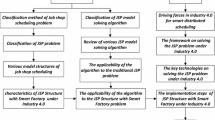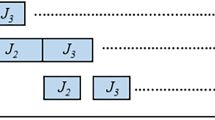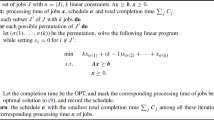Abstract
This paper addresses the large-scale extended job shop scheduling problem while considering the bill of material and the working shifts constraints. We propose two approaches for the problem. One is based on dispatching rules (DR), and the other is an application of the Nested Partitions (NP) Framework. A sampling approach for the exact feasible subregion is developed to complete the NP method. Furthermore, to efficiently search each subregion, a weighted sampling approach is also presented. Computational experiments show that the NP method with weighted sampling can find good solutions for most large-scale extended job shop scheduling problems.
Similar content being viewed by others
References
Adams, J., Balas, E., & Zawack, D. (1988). The shifting bottleneck procedure for job shop scheduling. Management Science, 34(3), 391–401.
Balas, E. (1969). Machine sequencing via disjunctive graphs: an implicit enumeration algorithm. Operations Research, 17, 941–957.
Blackstone, J., Phillips, D., & Hogg, G. (1982). State-of-the-art survey of dispatching rules for manufacturing job shop operations. International Journal of Production Research, 20(1), 27–45. doi:10.1080/00207548208947745.
Brucker, P., Jurisch, B., & Sievers, B. (1994). A branch and bound algorithm for the job-shop scheduling problem. Discrete Applied Mathematics, 49, 107–127. doi:10.1016/0166-218X(94)90204-6.
Carlier, J., & Pinson, E. (1989). An algorithm for solving the job-shop problem. Management Science, 35(2), 164–176.
Czerwinski, C., & Luh, P. (1994). Scheduling products with bills of materials using an improved Lagrangian relaxation technique. IEEE Transactions on Robotics and Automation, 10(2), 99–111. doi:10.1109/70.282535.
Dell’Amico, M., & Trubian, M. (1993). Applying tabu search to the job-shop scheduling problem. Annals of Operations Research, 41, 231–251. doi:10.1007/BF02023076.
Fisher, H., & Thompson, G. (1963). Probabilistic learning combinations of local job-shop scheduling rules. In J. Muth & G. Thompson (Eds.), Industrial scheduling. Englewood Cliffs: Prentice-Hall.
Ifinedo, P., & Nahar, N. (2007). Erp systems success: an empirical analysis of how two organizational stakeholder groups prioritize and evaluate relevant measures. Enterprise Information Systems, 1(1), 25–48. doi:10.1080/17517570601088539.
Nowicki, E., & Smutnicki, C. (1996). An advanced tabu search algorithm for the job shop problem. Journal of Scheduling, 42, 145–159.
Pan, Y. (2003). Production scheduling for suppliers in the extended enterprise. PhD thesis, Department of Industrial Engineering, University of Wisconsin-Madison.
Pinedo, M. (1995). Scheduling: theory, algorithms and systems. Englewood Cliffs: Prentice-Hall.
Shi, L., & Ó lafsson, S. (2000). Nested partitions method for global optimization. Operations Research, 48(3), 390–407. doi:10.1287/opre.48.3.390.12436.
Shi, L., & Pan, Y. (2005). An efficient search method for job-shop scheduling problems. IEEE Transactions Automation Science and Engineering, 2(1), 73–77. doi:10.1109/TASE.2004.829418.
Vaessens, R., Aarts, E., & Lenstra, J. (1996). Job shop scheduling by local search. INFORMS Journal on Computing, 8, 302–317.
van Laarhoven, P., Aarts, E., & Lenstra, J. (1992). Job shop scheduling by simulated annealing. Operations Research, 40, 113–125.
White, K. (1990). Advances in the theory and practice of scheduling. Advances in industrial systems. Control and Dynamic Systems, 37, 115–158.
Author information
Authors and Affiliations
Corresponding author
Rights and permissions
About this article
Cite this article
Yau, H., Shi, L. Nested partitions for the large-scale extended job shop scheduling problem. Ann Oper Res 168, 23–39 (2009). https://doi.org/10.1007/s10479-008-0370-x
Published:
Issue Date:
DOI: https://doi.org/10.1007/s10479-008-0370-x




